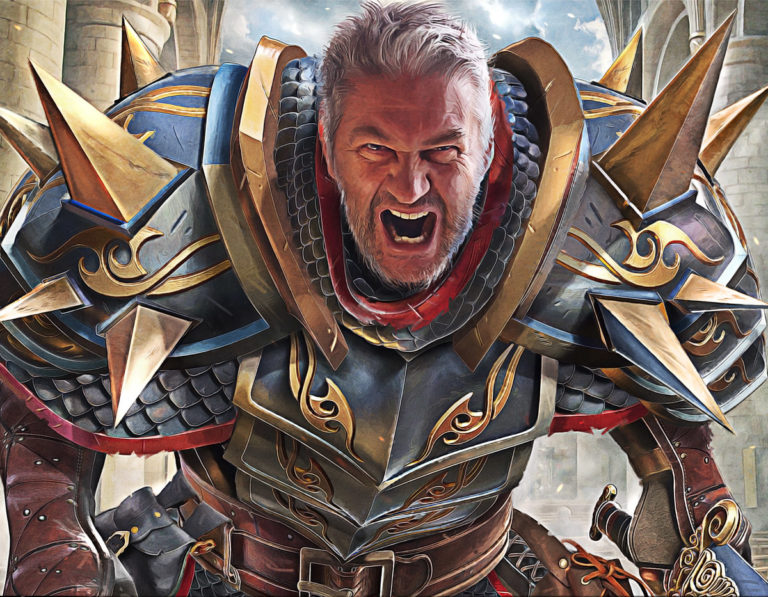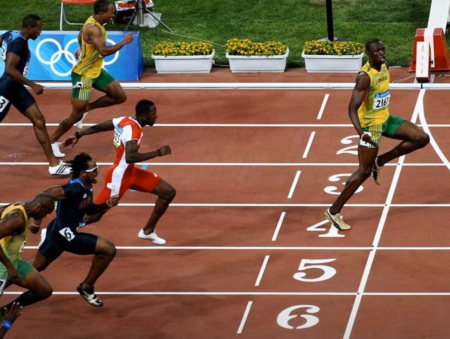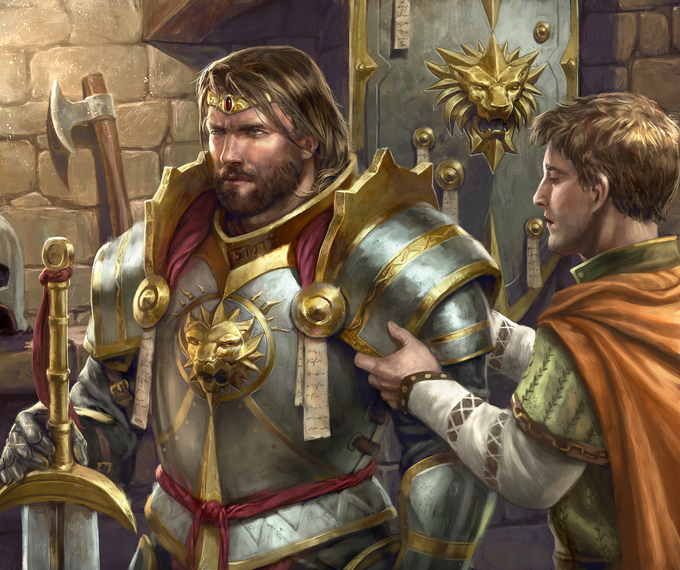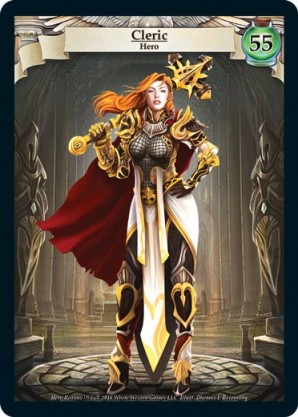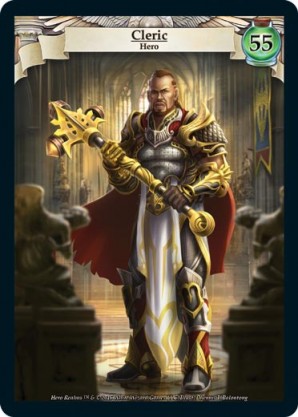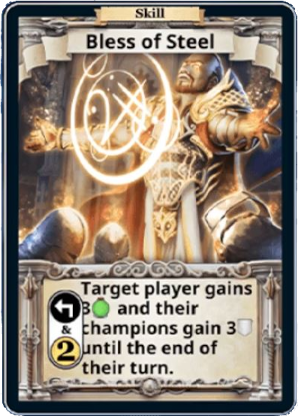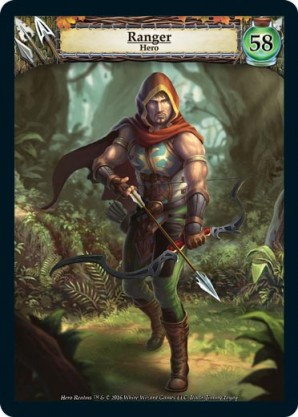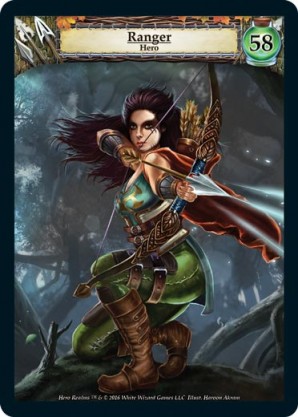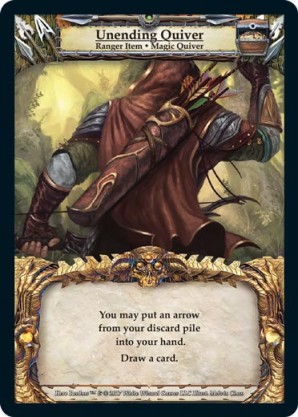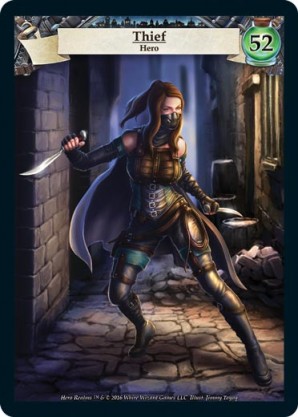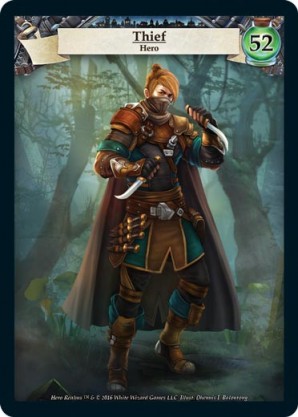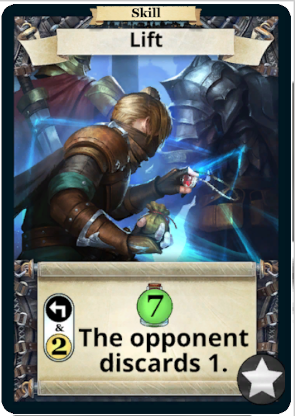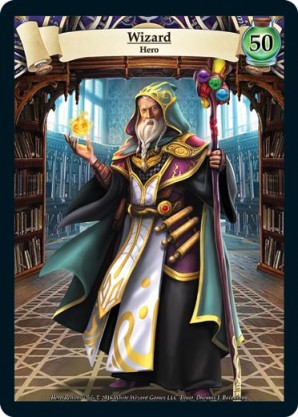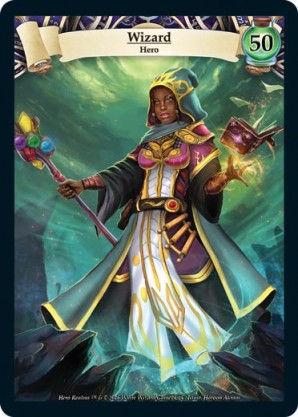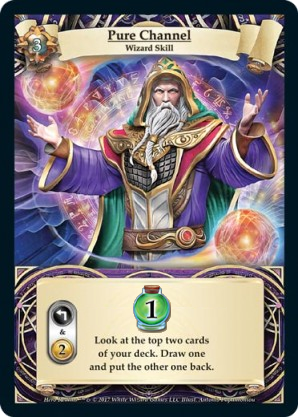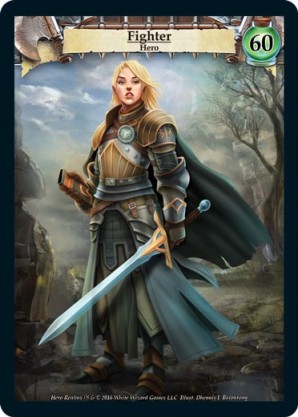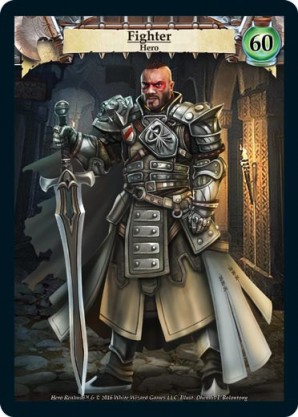In the first part of this series I covered the basic Fighter deck and upgrade options while leveling. In part two I am going to talk about the different basic deck archetypes, and how they match up with each other. Then I will cover the various hero class matchups you will see while playing a Fighter.
Counters to Aggressive decks
There are 3 basic ways your opponent will try to counter your aggressive damage game plan:
Lifegain. If you are dealing damage and your opponent is gaining health, they are going to neutralize your aggressive damage advantage. This can be done by buying the Yellow (Imperial) cards or using hero class abilities/cards that heal (basically every class besides Fighter has some sort of option to heal). They can also accomplish a similar effect by having a lot of champions in their deck. The more champions you need to damage (especially guards that cannot be bypassed), the less you get to apply to your opponent. Often your opponent will combine both of these and effectively neuter your damage output. In recent matches against highly ranked opponents I see this strategy a lot. Don’t leave those Imperial healing cards for your opponent if you have the chance to get them first.
Economy. Even without lifegain, if your opponent has an economy advantage they can buy the aggressive cards you want, and shut you out of the damage on the market row. This can be done by buying early economy cards or by having hero class abilities/cards that start them off with this advantage (see Thief and Wizard). Fighters are at the bottom of the economy curve at level 12 and will struggle in an economy race. Numerous and consistent discard effects can also lead to an economic advantage for your opponent. This starts us a step behind most other classes in ramping up our starting deck.
Faster, More Aggressive Damage. This is harder to pull off against a Fighter, but it is definitely possible. And you will see this in a mirror match. It is done by buying damage cards, especially damage combined with draw/cycle effects in order to make their damage faster than your own. After the recent balance changes, this is something to look out for. It was very difficult to out aggro a Fighter before, now it only takes some good luck from the Market or some good shuffles to accomplish this.
Okay I lied, there are more than three ways to counter an aggressive playstyle. The fourth option is a combination of two of the 3 options discussed above. Lifegain + Economy can really destroy a fast aggressive deck. I mean it will absolutely wreck you if you are not paying close enough attention and let your opponent gobble those cards up from the market row. Once they get enough of a lead here, there really is no way to recover and a loss is imminent. So you really need to pay attention to what your opponent is buying.
There is an old Star Realms reddit thread in which benjotron discusses the three basic deck archetypes and how they counter each other. While the faction specific stuff doesn’t translate 100% to Hero Realms, the general idea does. So I am going to share this with you here, and try to adjust that advice specifically to Hero Realms.
Strategic Dominance
There are three fundamental archetypes in the game – life gain, scrap, and damage. This can be seen in the factions generally as Imperial, Necros, Wild/Guild, though it isn’t quite as clear cut as in our sister game. We also have inherent class cards/abilities that further complicate things. If you follow one of these archetypes (buying mostly cards of that archetype’s color) and your opponent does the same, then most of the time: Lifegain will beat Damage. Damage will beat Scrap. Scrap will beat Lifegain. It’s like Rock, Paper, Scissors.
If your opponent is buying mostly Wild faction cards, you can counter by buying Imperial. If your opponent does not take steps to counter this you will have the advantage, and it will often lead to a win. IT IS WORTH BUYING CARDS THAT COUNTER YOUR OPPONENTS STRATEGY EVEN IF THIS DOESN’T ADVANCE YOUR STARTING PLAN. Understanding how to take advantage of this will improve your play and increase your win percentage.
You can also stop your opponent from countering your play by getting the cards they want before they have the chance to get them. When you buy the cards your opponent wants before they can purchase them, it is known as “counter drafting” or “hate drafting”. For this to be possible you need to have an understanding of what your opponent is doing, and know what cards will advance their plan. Knowing the basic archetypes will help make this possible.
Once you have a grasp of the basic game mechanics, you will need to incorporate more advanced strategies in order to beat a talented opponent. Great players know when to adjust, and how to counter their opponent’s play. This is really important! You can play a Fighter decently without knowing the basic archetypes, but great players take it into account when evaluating the market row and reading the current game state. Being versatile and understanding when to pivot to a different game plan are important skills. They are necessary to learn if you want to become a top player.
A smart opponent that takes steps to counter the built in damage advantage a Fighter has can often turn the tables and win that matchup. This will often look like the Fighter has an early lead and then runs out of steam letting the opponent finish things off. Knowing the basic archetypes will help you build a deck that will have a good chance to win any class matchup. Don’t be the noob who devalues Imperial faction cards because they aren’t aggressive enough. But also remember that there will be games that you did everything “right” and the inherent randomness of a deckbuilding game will lead to a loss.
The base effects and ally abilities when factioned are very strong and the lifegain can more than counter a very aggressive deck. The ally/faction effects are stronger in Hero Realms than they are in Star Realms, so we need to take that into account when evaluating our purchases. At the same time, aggression is our biggest strength, so it is best not to abandon it completely. Knowing when to lean into your hero’s natural strengths or when to pivot and counter your opponent is a higher level skill. It takes experience and an understanding of the game/deck mechanics.
So play games, challenge players with heroes who are difficult matchups, and don’t get discouraged. You will lose, but we all lose games. If you can discuss the game with your opponent on Discord or other chat channel, that will be even better. The truly great players analyze their play to understand why it was a win or loss, so that they can keep from making the same mistakes in the future.
The Matchups
For this last part I want to cover the matchups we have with other heroes (or other Fighters) and some basic strategies to deal with those matchups. This is a lot to cover, especially when you also account for those matchups across multiple levels in the app, so I can’t cover every possibility. I will try to give a good snapshot of how those matchups are at Low (1-5), Mid (6-10), and High (11-12) levels play.
Since there have been multiple balance changes affecting the Fighter so far in Beta, this part may be outdated for a short while after such a change. I will do my best to make changes here (if needed) within a week or so of such rebalancing. The general concepts should stay mostly the same, but that just depends on what WWG changes.
The Cleric
At low levels, this matchup isn’t horrible for us, but it gets increasingly difficult as the levels increase and becomes pretty tough for a Fighter. I would recommend following these tips regardless of level:
- Keep them from sacrifice if possible. Letting them thin their deck while throwing out champions and healing will make things nearly impossible to win.
- Go for “Card Advantage”. Draws, cycles, top-deck and to-hand effects. This keeps your deck from slogging down and lets you take advantage of your best cards more often.
- Get an early 4-5 defense guard if possible. The Cleric starts low on damage and an early guard will give them fits and let us get a quick edge we can exploit. Best if purchased in deck 1 or 2, after this point unless they completely ignore damage purchases, they won’t have as much trouble as early on. If you have the upgraded Shieldbearer this is built into your deck.
- Purchase champions. If we can buy champions before they do, we won’t let them build that wall as easily as they want. The champion to action ratio is high (34:46) so it’s improbable that we get every champion, but every champion we buy, they don’t have in their deck. It will also cause them to shift their focus from building their own wall to handling ours.
- Do not ignore the Imperial faction cards. You absolutely cannot let the Cleric have a monopoly on these. This is true of any opponent, but a Cleric doesn’t NEED them to heal, and adding them into their deck will let it get completely out of hand. Remember that lifegain is a good counter to damage, if they have a champion wall as well, it’s game over.
At lower levels, the Cleric has their healing and defense buff, but it isn’t a huge amount yet. They start with the same amount of economy as a Fighter and less damage. At this level they are much more dependent on a good Market Row than we are. A good opponent will make this match tough, but the Fighter has an edge here, especially if we can keep the game short by buying/playing damage aggressively.
At the middle levels this matchup starts to get tougher for us. The Cleric can have a fully upgraded bless or resurrect by level 6 and by level 10 they can have both. At levels 5 & 7 they have upgrade options to buff/draw with the Brightstar Shield, heal/draw with the Redeemed Ruinos, heal/resurrect with the Everburning Candle, and increase damage with the Veteran Follower. At level 9 they add the armor upgrade, I think the best bet is still the Phoenix Helm (40hp) which will add a draw when 2 or more champions are stunned since their previous turn, whereas the Shining Breastplate (10hp) can add +1 defense to a champion and is also very popular. Make sure to check what their build is and plan accordingly. Don’t waste your Crushing Blow to get them below this threshold unless you are sure they can’t heal back up above it. While either armor is beneficial to them, the benefits are not so great that I would really worry about shutting down their armor upgrade.
At the higher levels this matchup is THE WORST in the game. At level 11 you will most likely see them add the Hammer of Light which gives a +1 damage,+1 heal, and draws. The Talisman of Renewal adds more healing. This matchup is really hard to win, and you need RNG on your side to do so. The Cleric is built in such a way that it naturally counters a Fighter’s strengths. You have to either use a build that is made solely for this matchup or really hope RNG is on your side and your opponent makes multiple mistakes. Their healing counters our damage really well and they have an edge when it comes to economy (another of our weaknesses), so here I really say hope for luck when playing a good opponent cause you are going to need it.
The Ranger
A well piloted Ranger can be tough regardless of level, but this is a matchup that really depends on the quality of your opponents. I would recommend the following when facing a Ranger of any level:
- Keep them from draw cards. With the ability to track and “stack” their draw pile, we don’t want them to have more draw options than their base deck allows. This would also include the cycle (draw then discard) cards as well.
- Don’t let them monopolize sacrifice. They are already cycling through decks faster, letting them thin things down as well means they will destroy a Fighter. We don’t have to keep them from everything, but at least try to keep it roughly equal in sacrifice.
- Discard can be good, unless they have the quiver. It will just let them discard an arrow and pull it back to hand. So if that is the case you need more discard for it to have much of an effect.
- Get some lifegain. They will be cycling faster and possibly have a higher damage potential, so we need to counter with some lifegain and/or champions to slow down the effect of that damage. This will also keep them from getting these cards and stacking the powerful ally abilities!
At lower levels, a good opponent will make this a tough match, but they need some help from the Market Row. Without that we have the edge in this one. Their cycling with Track will be 3 cards, and so it won’t let them dig too deeply. It also costs 2 gold at this point and doing it too much early on will wreck their ability to get mid-high cost cards. They can stun a champion and draw with Headshot, hopefully we can force it at a time where they only really benefit from one of the two aspects.
In the middle levels things get a bit tougher. The Quickshot/Snapshot is probably more dangerous to us than the Twin/Triple Shot unless we have invested in a champion wall. They will also have the option to dig deeper with Careful/Flawless Track, or cheaper with Fast/Instinctive Track. Either way can be exploited against us, but a smart opponent will use these abilities to great effect. At level 5 and 7 they can get more damage with Honed Black Arrow, a Light Crossbow that can make the draw possibilities with arrows more consistent (and adds +1 damage to the gold it replaces), a Snake Pet champion that will let them stun a guard or draw a card, and the Unending Quiver let them pull an arrow from discard and draw a card. All of these are decent upgrades, but playstyle will differ slightly depending on what they have. The level 9 armor options are both at 30hp or above and are Hunter’s Cloak which gives 1 gold or 2 lifegain if they did more than 5 damage to us, or Sureshot Bracers which gives +2 damage if they played an arrow.
After level 10 their upgrade options are the Flashfire Arrow which draws a card and gives +2 damage if they have a bow in play or in hand, or Pathfinder’s Compass which lets them look at the top card of their draw pile and discard it if they want. The Ranger is the class on top of everything after the balance changes, so you need to work at countering their game plan. It’s definitely winnable, but we need some efficient cards from the Market in order to keep things going quick enough to finish them off. Fighter is one of their weaker (yet I would say they are still favored) matchups, so stick to your game plan and out aggro them.
The Thief
This matchup is interesting. It can be dangerous at any level, but is especially so at lower and higher levels. Some basic tips when facing a Thief are:
- Watch your shuffles and what is going into your discard. If the thief goes Skillful/Masterful Heist (or stays with basic Heist) they will have the ability to get something from our discard pile during their turn from turn 5 onward. Keep an eye on what their possible economy looks like and don’t buy a big card that will go into your discard only for them to immediately steal it.
- Be Aggressive! The Thief has lower starting health, so staying aggressive is a good bet unless the game state dictates that we change this up. If we can keep the pressure on them, then we get to dictate the pace and they are the ones that need to adjust.
- They are going to make us discard. This will be fairly constant, and most hands will be effectively 1 (or more) cards short most of the game. DO NOT let them get more discard effects from the Wild faction cards. This is imperative, otherwise we are going to be discarding our damage or the economy needed to improve our deck throughout the whole game.
- Get some early Gold. Some early economy cards can keep them from shutting us out of the Market Row, and can be good options to discard for their skill effect as well.
- Don’t let them have all the Imperial Cards. As with the Cleric, the Thief has lots of built in healing, so we don’t want them to get a lot more. They have an edge here already, but it can be overcome if we don’t let them amplify it with the Imperial cards.
At the low levels, I would say this can be a tough matchup if they have good Market Row options (or steal a bomb from our discard). Otherwise it slightly favors the Fighter if only because we have a higher starting health pool. A good opponent will always make it a tough matchup.
At level 6 the Thief gets access to Misdirection/Distracted Exchange/Lift. They all make us discard a card and heal the thief, Misdirection and Distracted Exchange also have the effect that gives them gold on their next turn if the discarded card doesn’t have a cost (i.e. a starter card like gold). This healing can be hard to deal with (especially the options that give 5 or 7 health). When Heist is upgraded it can lead to some nifty shenanigans allowing them to get something directly to hand. Make sure to see what version they have upgraded to as this will dictate whether we need to be careful with our shuffles/purchases or if we want to try to steal something from the Market Row that will let them get an edge by getting a great card directly into play.
The level 5 and 7 item upgrades can increase damage with Keen Throwing Knife, deal damage to non-guards using Enchanted Garrote, Draw cards with Knife Belt, and sacrifice a card in hand with Sacrificial Dagger. It doesn’t matter to us so much which of these they have, just keep in mind what they do and watch for extra damage, scrap, or draw depending on what they ended up with. For the level 9 armor there is Shadow Mask (35hp) which can top deck a card of 3 cost or less from their discard, or Silent Boots (10hp) which lets them reveal the top card of the market draw pile and either sacrifice it from play or purchase it at a 1 gold discount. If they have Shadow Mask you should get them under 35hp ASAP, use Crushing Blow and Shoulder Crush and whatever damage you have to keep them from top decking cards they just bought. Silent Boots is at 10hp, so no need to focus on removing it because the game will soon be over once you do.
At higher levels, especially 12, the difficulty of this matchup is really dependent on what their build is. They will get Blackjack at level 11, giving a damage and draw (and sacrifice for expending a champion). Jeweler’s Loupe is the other option and will give 1 gold, or let them pull a fire gem or ruby from discard into their hand. A thief that picked the higher lifegain skill is more difficult to deal with as they can spend 2 gold to heal 5 or 7 while we spend 2 gold for 4 damage, they also have better starting economy so getting some early economy cards can keep us in the game. Sacrifice cards from the Necros faction will help thin out your deck and give you an edge against their healing.
The Wizard
The Wizard matchup has seen some recent changes, and we should not write this off as an easy win. A good Wizard player probably has a decent chance at winning this matchup, but I think we still have the edge here overall. Whatever level, keep the following in mind:
- Damage, Damage, Damage! The health pool is low even if they got an upgrade or two so we can burst it down fairly quickly. They have a few more healing options now and we need to keep the pressure one or they will run away with things.
- Keep them from getting draw effects whenever possible. This will slow their engine down and keep the combo possibility lower.
- Watch out for Fireball. If you have a lot of champions, then hopefully you make them use it early and get the wall back up quickly. I find that going for a champion wall is bad strategy against a Wizard anyway, but if that’s the way the Market Row forces things, hopefully they don’t keep decimating it.
- Keep the game short. They can scry and do some draw/deck manipulation so be wary and just kill them as quickly as possible before they can get their combos off. If you give them time to set things up they can do some crazy damage.
- Keep them off of lifegain. They have low hp, don’t let them increase it! I have seen wizards combo draw effects to gain around 40hp in a turn, so don’t let them have that option.
At the lower levels, the Wizard doesn’t have a ton of great tools and their health pool is the smallest. A good opponent is dangerous regardless of the hero they are playing, so stay focused here! Jigmelingpa wrote a nice article on the wizard and reading that can help you to know what they are wanting to do, and when you know that you can counter it!
From level 6-10 they start to accumulate the tools that give them a chance to just “go off”. At levels 5 and 7 they can add Silverskull Amulet to their deck which gives them 2 gold and can be trashed to draw a card. Blazing Staff upgrades Fire Staff, increasing to 3 damage and keeping the draw ability if two actions have been played. Serpentine Staff replaces a gold and does 2 damage to all opposing champions (like a mini Fireball). Arcane Wand draws a card and does +1 damage for each action played the rest of the turn. There are a lot of combo possibilities in these upgrades, so be ready! At level 9 the armor upgrades available are Runic Robes (10hp) which let them set aside a card to put into their next hand of cards and Spellcaster Gloves (10hp) which grant 2 dmg or 3 hp if two or more actions have been played. Runic Robes is still probably the best option, but the gloves are popular now as well.
At higher levels the wizard gets some more draw ability at level 11 with Magic Mirror, or some economy with Alchemist’s Stone. The Magic Mirror is the last tool they get that sets them up to get off some great combos. The draw potential at this point can be pretty nuts, so hopefully we can keep them from drawing anything good! Watch out for wizard builds that have lots of healing (the Spellcaster Gloves and Serene Channel specifically). Keeping them from the Imperial cards, especially those that draw and have lifegain, will keep the match short, and allow us to burst them down before they can get set up to explode.
The Mirror
I am not going to say a ton here, hopefully by this point you have a good idea of what a Fighter can do and how they want to do it, but I do want to point a few things out. The Fighter vs Fighter matchup in the early levels is almost completely decided on who builds a better engine. We start with close to identical decks, so the edge is found by getting the better deck built and watching it do work. At the middle levels we will see more variance in builds and if you have gone for a damage build and they have gone for the expend build, you will have a slight edge. Our starting deck is quicker and RNG becomes a bigger factor at this point. You should hopefully have a health upgrade at some point here, and if your opponent does not then your chances increase drastically.
At the Higher levels I have found it comes down to a few factors:
- RNG. First player has an advantage, and shuffles are important. If you have a bad shuffle later in the game it can greatly lower your chance at winning.
- Health upgrades. If you have more health than your opponent, then it is an uphill battle for them to overcome. +9hp can mean an extra turn or 2 to finish the game.
- The Market Row. Good decisions leading to purchases from the Market Row that give us a higher damage burst potential can turn the tide in a mirror match.
- Be smart about using Crushing Blow (or it’s upgrades). A few things to always keep in mind with Crushing Blow are hp thresholds for their armor upgrade, taking out a champion wall (or larger defense champion), a killing blow, or triggering your throwing axe when you don’t otherwise have the damage. Using it to trigger the draw from throwing axe can be tricky, just make sure it’s actually useful to do so.
Other things matter in this matchup, but those are the main things I have seen decide a game against another Fighter.
So I have covered a lot in this series, but hopefully it was helpful to new and advanced players alike. By reading through the both articles, you should be familiar with the basic Fighter deck, it’s upgrade and ability options when leveling, the main deck archetypes, and the individual class matchups from a Fighter’s perspective and some tips on how to win some of them.
